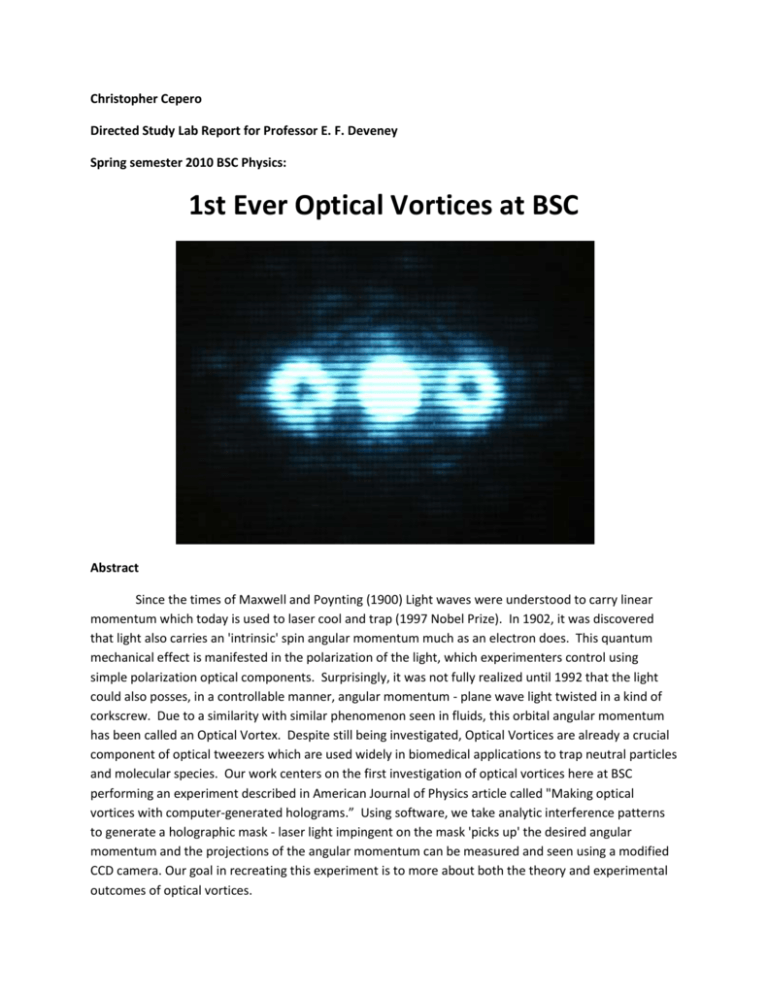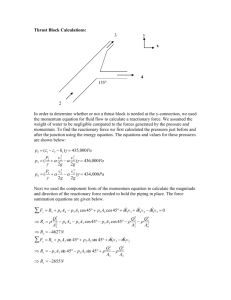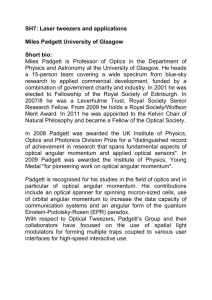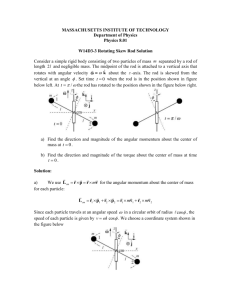Final OVortices-Paper-Chris-Cepero - Deveney-BSU
advertisement

Christopher Cepero Directed Study Lab Report for Professor E. F. Deveney Spring semester 2010 BSC Physics: 1st Ever Optical Vortices at BSC Abstract Since the times of Maxwell and Poynting (1900) Light waves were understood to carry linear momentum which today is used to laser cool and trap (1997 Nobel Prize). In 1902, it was discovered that light also carries an 'intrinsic' spin angular momentum much as an electron does. This quantum mechanical effect is manifested in the polarization of the light, which experimenters control using simple polarization optical components. Surprisingly, it was not fully realized until 1992 that the light could also posses, in a controllable manner, angular momentum - plane wave light twisted in a kind of corkscrew. Due to a similarity with similar phenomenon seen in fluids, this orbital angular momentum has been called an Optical Vortex. Despite still being investigated, Optical Vortices are already a crucial component of optical tweezers which are used widely in biomedical applications to trap neutral particles and molecular species. Our work centers on the first investigation of optical vortices here at BSC performing an experiment described in American Journal of Physics article called "Making optical vortices with computer-generated holograms.” Using software, we take analytic interference patterns to generate a holographic mask - laser light impingent on the mask 'picks up' the desired angular momentum and the projections of the angular momentum can be measured and seen using a modified CCD camera. Our goal in recreating this experiment is to more about both the theory and experimental outcomes of optical vortices. Introduction Optical vortices are caused by a quantum mechanical effect, called orbital angular momentum. In accordance with the principle of conservation of momentum, light waves have a total angular momentum. This total angular momentum is part spin angular momentum, and part orbital angular momentum. In physics, a vector exists called the Poynting vector. This vector describes the direction and magnitude of the momentum carried in a light wave. In a light wave that has a helical orientation, the pointing vector has a component of the orbital momentum in the azimuthal direction. Figure 1: Image of a helical wavefront with its pointing vector. (Padget, Courtial, Allen, 2004) This momentum that seems to rotate about the direction of propagation is called the optical vortex, and is directs the angular momentum parallel and anti-parallel to the direction of propogation. The angular momentum can be seen as a donut shape, a ring illuminated by the laser with a dark spot in the center. To observe the vortex caused by the orbital angular momentum, the beam must be interfered with a plane wave of a similar coherence. Optical vortices have a wide range of applications, both in the field of physics and in other fields. They are being looked into for experiments involving waveguiding, Bose Einstein condensates, superfluidity, and even extrasolar planet searches. The use of optical vortices as a component of optical tweezers is also an important application, because optical tweezers are not only used in biomedical applications, but also in biology and chemistry research. It is important to have such an experiment available to physics students to give them an introduction to optics principles, and to further solidify quantum mechanical concepts. The possibility of bringing optical tweezers to BSC is also a worthwhile endeavor that this project will help make possible. The experiment from the AJP article “Making optical vortices with computer-generated holograms” is a simple and cost effective way to observe optical vortices. The article describes how to “imprint” a laser beam with an angular momentum by directing it through an optical mask. The optical mask is created by first graphing a function that describes the pattern using mathematical software. This pattern can then be made into an optical mask by printing it with a very precise printer onto special film paper, or by printing it out on normal paper and photographing it with an analog camera and black and white film and using the negative itself as the mask. The article goes on to explain how a web camera can be used as an inexpensive alternative to a CCD sensor by removing the focusing lens. The CCD camera is needed to capture the image of the optical vortex. Lastly, the apparatus described by this article is fairly simple to set up, requiring a few pieces of optics equipment such as a couple beam splitters, a diaphragm, some mirrors and a Helium Neon laser. Methods We begin our experiment by collecting the lab equipment available to us to determine if we need to purchase any equipment. We have determined that we have the correct equipment for the apparatus, but our equipment is designed for a 780nm laser, and the paper calls for the use of a 633nm laser. Thus our first goal in this process is to characterize the efficiency of the beam splitters by using a power meter. The beam splitter is designed to split a 780nm laser 50/50, so the power of the two beams that leave the splitter should be half the power of the original beam. The results of this venture are the following: The power measured of the helium-neon 633nm laser was measured to be 0.566W. The power of the transferred beam is 60% the power of the original beam, measured between 0.238 and 0.315W. The reflected beam retained 40% of the power at between 0.120 and 0.230W. Furthermore, the power of the two derivative beams seems to fluctuate a great deal, while the power of the original beam was fairly steady. We determined that despite the slight difference in the power of the beams, the beam splitter works efficiently enough for us to use in the experiment. Another possible choice is to simply redesign the experiment for a 780nm laser. The next task is to create the holographic mask that will form the vortex when the laser passes through it. This is done by printing the pattern generated by the function: 2 𝐻 = |𝜓1 + 𝜓2 |2 = |𝑒 𝑖𝑘𝑥 + 𝑒 𝑖𝑚𝜃 | = 2(1 + cos(𝑘𝑥 − 𝑚𝜃)) (𝑒𝑞𝑢𝑎𝑡𝑖𝑜𝑛 1) where m is the topological charge of the vortex, which physically refers to the velocity of the phase rotation around the singularity. (Carpentier et al.) This calculation is performed by taking the complex conjugate of the wavefunctions: 2 ∗ 𝐻 = |𝜓1 + 𝜓2 |2 = |𝑒 𝑖𝑘𝑥 + 𝑒 𝑖𝑚𝜃 | = (𝑒 𝑖𝑘𝑥 + 𝑒 𝑖𝑚𝜃 ) (𝑒 𝑖𝑘𝑥 + 𝑒 𝑖𝑚𝜃 ) = (cos(𝑘𝑥) + 𝑖𝑠𝑖𝑛(𝑘𝑥) + cos(𝑚𝜃) + 𝑖𝑠𝑖𝑛(𝑚𝜃)) ∗ (cos(𝑘𝑥) − 𝑖𝑠𝑖𝑛(𝑘𝑥) + cos(𝑚𝜃) − 𝑖𝑠𝑖𝑛(𝑚𝜃)) 𝐻 = cos2 𝑘𝑥 − 𝑖 cos 𝑘𝑥 sin 𝑘𝑥 + cos 𝑘𝑥 cos 𝑚𝜃 − 𝑖 cos 𝑘𝑥 sin 𝑚𝜃 + 𝑖 cos 𝑘𝑥 sin 𝑘𝑥 + sin2 𝑘𝑥 + 𝑖 cos 𝑚𝜃 sin 𝑘𝑥 + sin 𝑘𝑥 sin 𝑚𝜃 + cos 𝑘𝑥 cos 𝑚𝜃 − 𝑖 cos 𝑚𝜃 sin 𝑘𝑥 + cos 2 𝑚𝜃 − 𝑖 cos 𝑚𝜃 sin 𝑚𝜃 + 𝑖 cos 𝑘𝑥 sin 𝑚𝜃 + sin 𝑘𝑥 sin 𝑚𝜃 + 𝑖 cos 𝑚𝜃 sin 𝑚𝜃 + sin2 𝑚𝜃 𝐻 = cos 2 𝑘𝑥 + sin2 𝑘𝑥 + cos 2 𝑚𝜃 + sin2 𝑚𝜃 + 2 cos 𝑘𝑥 cos 𝑚𝜃 + 2 sin 𝑘𝑥 sin 𝑚𝜃 = 1 + 1 + 2 cos 𝑘𝑥 cos 𝑚𝜃 + 2 sin 𝑘𝑥 sin 𝑚𝜃 = 2(1 + cos 𝑘𝑥 cos 𝑚𝜃 + sin 𝑘𝑥 sin 𝑚𝜃) = 2(1 + cos(𝑘𝑥 − 𝑚𝜃)) We will plot this in labVIEW and Maple to create a graph of the intensity, which should result in a pattern similar to those in the AJP article: Figure 2: The plots of H for m=1 to m=6 (Carpentier et al, 2008). By photographing the interference pattern we create with an analog camera and black and white film, we can use the developed negative as our holographic mask. The holographic mask will imprint our He-Ne laser with an orbital angular momentum, and the resulting interference pattern will result in ring of light. Figure 3: Image of the interference pattern created when the laser is run through the holographic mask (Padget, Courtial, Allen, 2004) In order to observe the vortex pattern caused by this momentum, the encoded laser beam must be interfered with a coherent plane wave. By using a beam splitter and a couple of mirrors, this can be accomplished with relative ease. Figure 4: Apparatus to view the vortex pattern. (Carpentier et al, 2008) Once the laser beams recombine, we will image the resulting pattern with a CCD camera. Figure 5: Image of the vortex pattern caused by interfering the beams. (Padget, Courtial, Allen, 2004) Results After plotting equation (1) in Maple and LabVIEW, both programs yielded images comparable to those depicted in the AJP article. Figure 6: Our plot of equation (1), m=2 in maple (left) compared to the image in the article (right) (Carpentier et al. 2008). Although our odd numbered interference patterns are not identical to those seen in the AJP article, they have a close resemblance and the even numbered patterns are identical. Figure 7:Our plot of equation (1), m=3 in maple (left), compared to the image in the article (right) (Carpentier et al.). We printed out 5in X 5in images of the interference patterns that contained 40 dark fringes. Working with the BSC photography departments Professor Nunez, we took multiple photos of the six different interference patterns and developed the film. We then proceeded to run the experiment as described in the AJP article using the negative images as our optical masks. Figure 8: Initial set-up to image the angular momentum It took many small adjustments to the orientation of the mask before we were able to see the donut pattern that is indicative of the presence of the orbital angular momentum. Figure 9: Orbital angular momentum interference pattern. Conclusions The pattern in figure (9) marks the first time optical vortices were generated at Bridgewater State College. We were able to successfully encode the laser beam with an orbital angular momentum. There is still a lot of potential in the future of this project. We still need to image the vortex pattern of the orbital angular momentum by using the apparatus in figure (4). Furthermore there are several experiments that can be done using the same apparatus that are described in the AJP article. For our purposes however, the completion of this experiment is in the imaging of the vortex pattern, and that is where the immediate future of this project lies. References A.V. Carpentier et al., “Making optical vortices with computer-generated holograms,” Am. J.Phys. 76, 916-921 (2008). Miles Padgett, Johannes Courtial, Les Allen; “Lights Orbital Angular Momentum,” Physics Today. 76, 35-40 (2004). Acknowledgements: Dr. Nunez: A professor of the photography department at BSC. She took the photos of the interference patterns (figures 6 and 7) and developed the film. Dale Smith: A fellow student at BSC who helped format the images of the interference patterns to retain quality when enlarged and printed. APPENDIX: Making the Masks: First, you must define a function as equation (2) from the AJP paper. Then, you have to load the plots part of the program by typing in “with(plots);”. To get a printable image, we use the “densityplot” input. The plot is of the function (in the image it is “ f ”) with a range of -120 to 120 for both x and y, and a grid of [1200,1200]. Note that having such a large grid will cause Maple to take a fairly long time to generate the image, but it is necessary to obtain enough quality that the printed image won’t be affected. In the picture, the grid is [300,300] simply to see if the pattern is correct. I recommend only creating one image at a time, and closing Maple before reopening it to create the next image. This seems to speed up the process of generating the pattern. After plotting the function, right click on the graph, go to style, and select polygon (w/o outline). This will allow you to see the actual image. Then right click again, go to axes and select no axis to get rid of the axis lines for printing. You can avoid these steps by including “style=patchnogrid, axes=none” in the density plot function as is seen in the picture. To save the image, simply right click on it, go to export, and select the desired format (I think I used JPEG, but BITMAP works too). Saving the image as a JPEG will also take a good deal of time because of the detail in the image. You can change the value of m from 1 to 6 (it is the 6 in the picture). For Labview: In the first box, outside both of the squares I used a value of 750. For the inner box, I also used a value of (1000). Both were divided by 2. With the aforementioned values, you get the following image. If you increase the outer box value, the view of the image seems to get farther out. A better way to explain is that the number of lines increases, making it seem like it gets farther. Conversely, lowering the number causes the number of lines to decrease, and the picture gets closer to the center. Values of the outer box of 500, 750, and 1000 respectively. If you increase the inner box value, the center of the image condenses, and the curves of the “prong” shapes become flatter. Conversely, decreasing the value makes the center more smooth/straight. Values of 500, 1000, and 1500 for the inner box respectively. Increasing or decreasing the number it is divided by moves the image. For example, increasing the outer divided number above 2 moves the image right, and decreasing it below 2 moves it left. Values of 1, 2, and 3 used for the outer divided number respectively. Increasing the inner divided number moves the image down, and decreasing it moves the image up. Values of 1, 2, and 3 for the inner divided number respectively.








